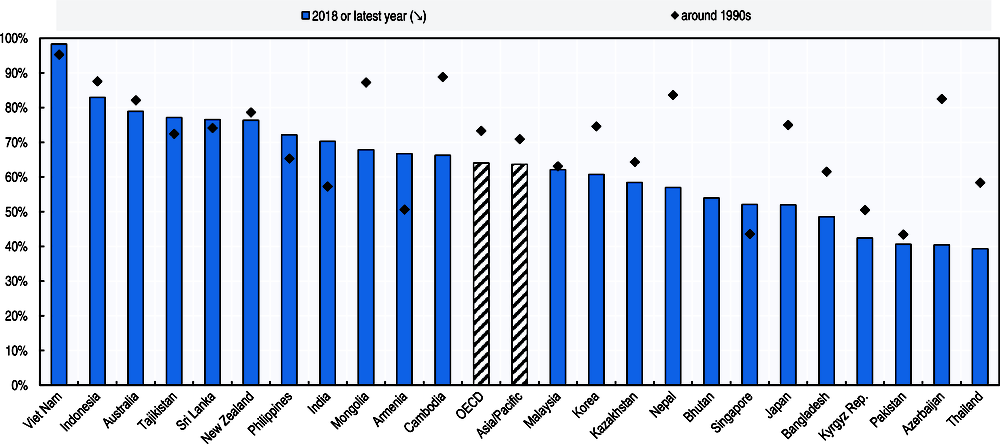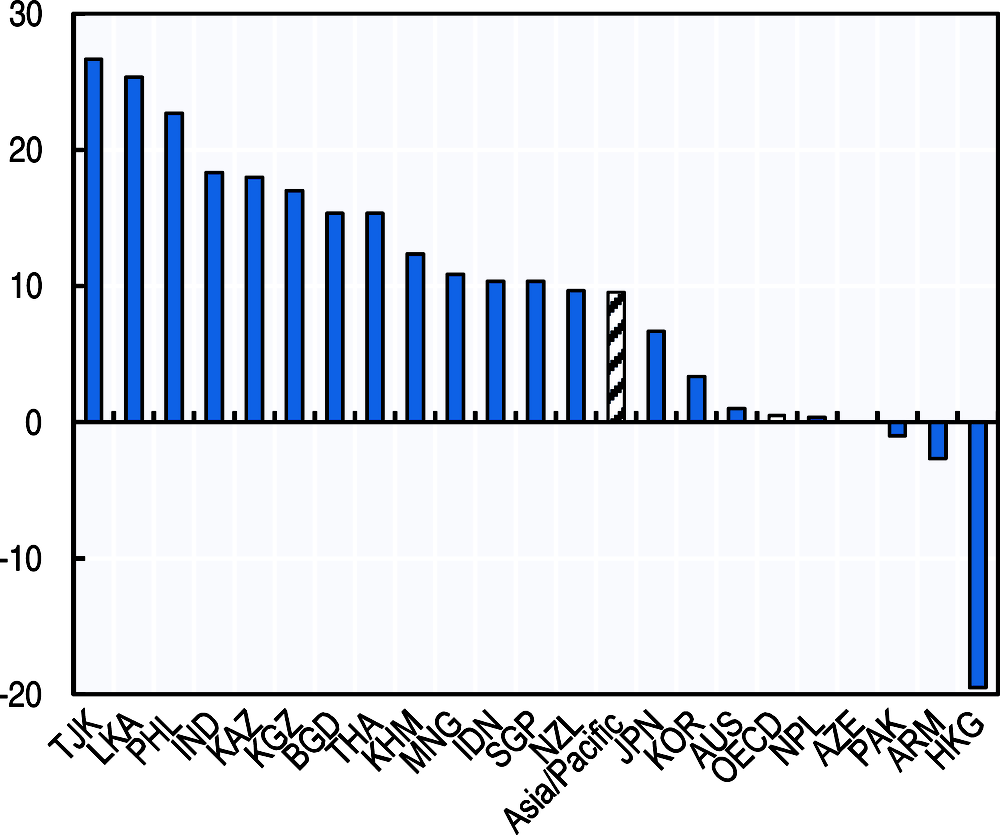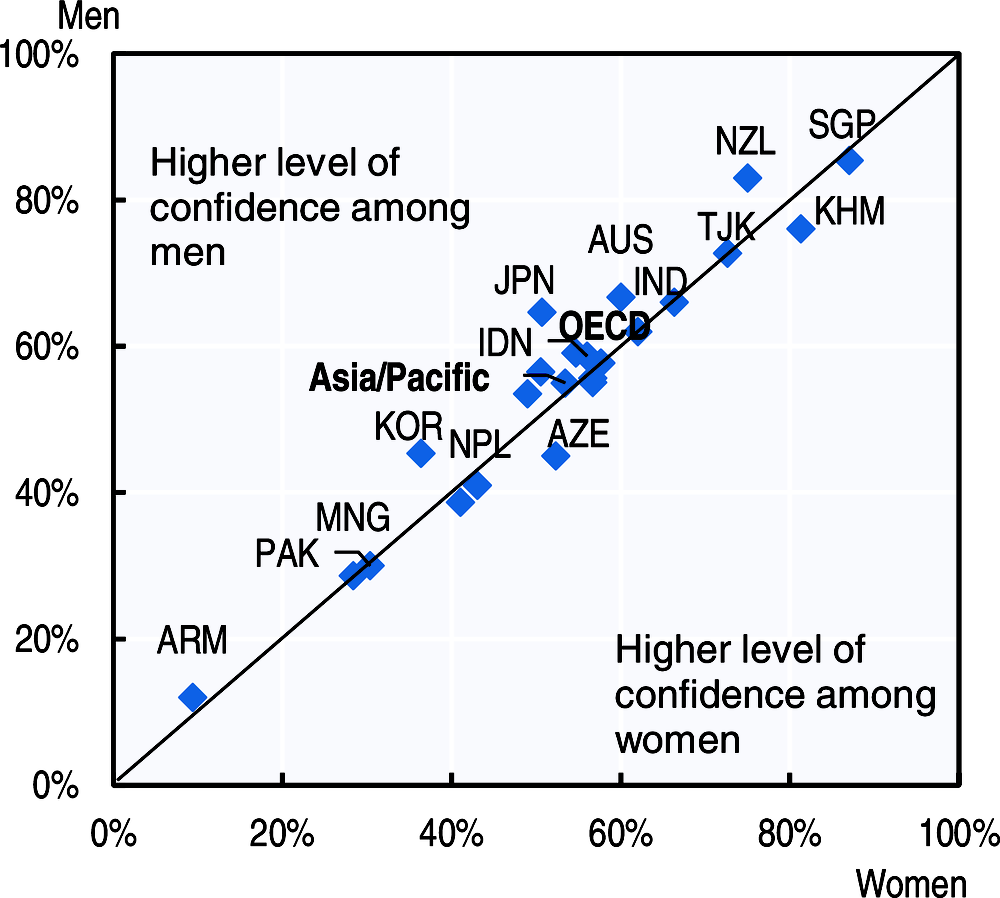Voting
A high voter turnout is a sign that a country’s political system enjoys a strong degree of participation. Voter turnout rates vary hugely across the region (Figure 7.13). Over eight in every ten people turn out to vote in parliamentary elections in Viet Nam, Lao PDR and Indonesia, compared to less than one in every two people in Azerbaijan, Kyrgyzstan, Pakistan and Thailand, the lowest turnouts in the Asia/Pacific region. In all other countries for which data is available on voter turnout in parliamentary elections, more than half of the eligible population votes.
Voter turnout has generally declined in most OECD and Asia/Pacific countries (Figure 7.13). Azerbaijan and Nepal have experienced the sharpest decline in voter turnout since the 1990s, but since then voter participation in national elections turnout also dropped significantly in Bangladesh, Cambodia, Japan, Korea and Mongolia and Thailand. In contrast, voter participation increased most in Armenia and India since the 1990s.
Confidence in the electoral process is an essential element for civic participation of citizens. Trust in honesty of elections increased in most countries across the Asia/Pacific region (Figure 7.14). Confidence in fair elections increased most in the Philippines, Sri Lanka and Tajikistan (by more than 20 percentage points) while the largest decline in trust in the election process was observed in Hong Kong, China.
Men and women often have similar levels of confidence in honesty of elections (Figure 7.15). In some Asia/Pacific countries that do not belong to the OECD, women tend to trust the electoral process more than men, and the gender gap is around 5-7 percentage points in Azerbaijan and Cambodia. By contrast, in Australia, Japan, Korea and New Zealand, women have less confidence in the fairness of electoral processes with a gender gap of around 8 to 10 percentage points.
Figure Note
Figure 7.13. Voting age population turnout, i.e. the percentage of the voting age population that actually voted – as available from administrative records of member countries.
Voting in national parliamentary elections is one indicator of people’s participation in their community’s national life. The indicator used here to measure the participation of individuals in the electoral process is the “Voting age population turnout”, i.e. the percentage of the voting age population that actually voted – as available from administrative records of member countries. Different types of elections occur in different countries according to their institutional structure and different geographical jurisdictions. For some countries, it should be noted, turnout for presidential elections and regional elections may be higher than for national parliamentary elections, perhaps because those elected through these ballots are constitutionally more important for how those countries are run. Data about voter turnout are extracted from the international database managed by the Institute for Democratic and Electoral Assistance (IDEA).
Data on confidence in “fairness of elections” has been taken from the Gallup World Poll. The Gallup World Poll is conducted in more than 150 countries around the world based on a common questionnaire, translated into the predominant languages of each country. With few exceptions, all samples are probability based and nationally representative of the resident population aged 15 years and over in the entire country, including rural areas. While this ensures a high degree of comparability across countries, results may be affected by sampling and non-sampling error, and variation in response rates. Hence, results should be interpreted with care. These probability surveys are valid within a statistical margin of error, also called a 95% confidence interval. This means that if the survey is conducted 100 times using the exact same procedures, the margin of error would include the “true value” in 95 out of 100 surveys. Sample sizes vary across countries from 1 000 to 4 000, and as the surveys use a clustered sample design the margin of error varies by question. The margin of error declines with increasing sample size: with a sample size of 1 000, the margin of error at a 95% confidence interval is 0.98/ or 3%; with a sample size of 4 000, this is 1.5%. To minimise the effect of annual fluctuations in responses related to small sample sizes, results are averaged over a three-year period, or two-year period in case of missing data. If only one observation in a three-year period is available this finding is not reported.
or 3%; with a sample size of 4 000, this is 1.5%. To minimise the effect of annual fluctuations in responses related to small sample sizes, results are averaged over a three-year period, or two-year period in case of missing data. If only one observation in a three-year period is available this finding is not reported.
Data on confidence in the fairness of elections is based on the following question: “In this country, do you have confidence in each of the following, or not? How about honesty of elections?”



